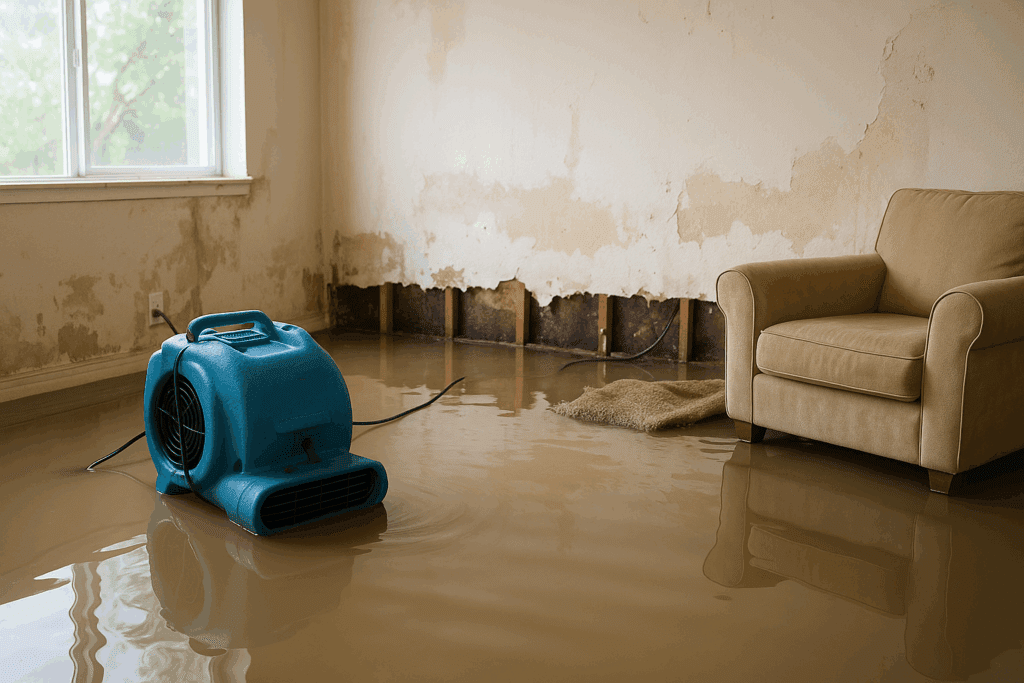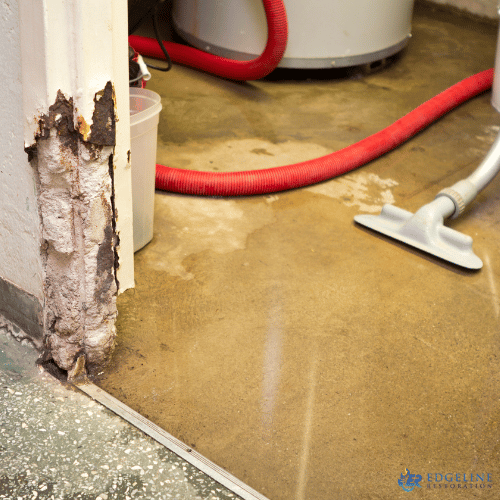
Picture this: you come home after a long day, ready to relax. You take off your shoes, head into the kitchen, and notice a small puddle of water by the sink. You hope it’s just a spilled drink—but then you see the water is actually seeping out from behind the cabinet.
Suddenly, you’re dealing with a leak you never knew you had. Water damage can sneak up on you like this, turning a calm evening into a panicked race to stop the drip before it gets worse.
At Edgeline Restoration, we’ve seen just about every water damage scenario you can imagine—everything from minor pipe leaks to full-on floods that ruin floors and walls. We know how disruptive water damage can be, not just for your home but for your peace of mind. That’s why we’re dedicated to offering quick, reliable help if the worst happens.
We specialize in water damage restoration, serving our neighbors in Marysville, Arlington, and surrounding areas. If you’ve been searching for water damage restoration near me, look no further: we’re right here in your community, ready to lend a hand.
In this post, we’ll talk about five common causes of household water damage. We’ll explain why they happen, how to spot them, and most importantly, how to keep them from turning your home into a soggy mess. Whether you own a home or rent, it’s always smart to be aware of these risks.
A bit of knowledge can go a long way toward preventing costly repairs—and we’re here to guide you every step of the way.

Why Water Damage Is So Stressful (and Why Prevention Matters)
1. Hidden Plumbing Leaks & Burst Pipes
Why This Happens
Plumbing leaks can be sneaky, especially if they’re behind walls or under floors. Pipes corrode over time, connections loosen, and temperature shifts (like freezing winters) can cause small fractures. When a pipe bursts, water often gushes out uncontrollably until you shut off the main valve, leaving you with soaked drywall, ruined carpets, and a mountain of stress.
Early Warnings
- You notice a sudden spike in your water bill.
- You see or smell dampness under sinks or behind toilets.
- The water pressure in your shower or faucets drops unexpectedly.
- Paint bubbles or discoloration appears on your ceiling or walls.
How to Prevent It
- Routine Checks: Peek under sinks every month or so. Look for moisture or discoloration.
- Insulation: In cold climates, wrap exposed pipes to prevent freezing.
- Monitor Water Pressure: High pressure puts extra stress on pipes. Installing a pressure regulator can help if your home pressure is over 60 psi.
What to Do If It Happens
First, shut off your main water supply to stop the flow. Next, call water damage contractors—ideally, a trusted local team like Edgeline Restoration. We’ll figure out exactly how much water escaped, use professional equipment to dry everything out, and restore any damage. Acting fast is the key to keeping repairs (and costs) under control.
2. Leaking or Malfunctioning Appliances
Why This Happens
Your washing machine, dishwasher, refrigerator, and water heater are all prime suspects for leaks. Over time, hoses can crack or split, and the seals on doors may wear out. Sometimes an internal component just gives up, causing water to overflow. Even overloading your washer can push it past its limits, leading to a flooded laundry room.
Warning Signs
- Pools of water under or behind appliances
- Strange noises or shuddering when the appliance is running
- Cycles taking longer than usual or failing to complete
- Rust or mineral buildup around hose connections
How to Prevent It
- Change Hoses Regularly: Most manufacturers recommend replacing hoses every 3–5 years.
- Don’t Skimp on Installations: Make sure a knowledgeable professional installs new appliances.
- Check Seals and Gaskets: For dishwashers and fridges, a worn door seal can let water escape.
What to Do If It Happens
Unplug and shut off the water supply to the appliance right away. Mop up as much water as you can, but remember there could be more moisture trapped under flooring or in the walls. That’s when a professional water damage restoration service is your best friend. At Edgeline Restoration, we’ll check for hidden water pockets, dry everything thoroughly, and make sure mold doesn’t become a follow-up disaster.
3. Roof and Gutter Issues
Why This Happens
Your roof takes a beating from the elements year-round. Wind, rain, and snow can wear down shingles and cause them to crack or come loose. If a seal around a chimney or vent fails, water can slip in and drip into your attic. Meanwhile, gutters can clog with leaves, pine needles, or even bird nests, preventing water from draining properly. When that happens, water can spill over the edges and seep into your home’s exterior walls or foundation.
Clues to Look For
- Brownish water stains on your ceiling
- Drips or moisture in the attic after a storm
- Overflowing gutters when it’s raining
- Shingles that look curled, bent, or are missing
Prevention Tips
- Seasonal Roof Inspections: A quick annual check by a roofing pro can spot damage early.
- Clean Gutters: Twice a year (usually in spring and fall) is standard. More often if you have a lot of trees around.
- Fix Small Problems Fast: A tiny roof leak can escalate quickly.
How Edgeline Restoration Can Help
If water does sneak in from above, our water damage restoration contractors can assess how far the moisture has spread in your attic, insulation, and ceiling. We’ll then use high-powered fans, dehumidifiers, and moisture meters to dry things out completely. That way, you won’t have to worry about mold, structural weakening, or persistent odors from hidden dampness.
4. Foundation Cracks & Drainage Problems
Why This Happens
Homes naturally settle over time, and the ground beneath them can shift. When that happens, small cracks often appear in the foundation. Heavy rain or melting snow can then force water through these cracks. Poor grading around your house or clogged exterior drains can also direct water toward your foundation instead of away from it.
Red Flags
- Cracks in the basement walls or floor
- Puddles forming around the outside of your home after a storm
- Musty odors in the basement, or floors feeling damp
- Windows or doors that suddenly don’t close right (could be a sign of shifting foundation)
Keeping Your Foundation Dry
- Improve Drainage: Make sure the ground slopes away from your home. You might need to add soil or install a French drain system.
- Fill Small Cracks: Use a concrete patch or waterproof sealant. For bigger cracks, consult a structural engineer.
- Sump Pump: In very wet areas, a sump pump can be a lifesaver, pumping water out before it pools.
Our Approach
At Edgeline Restoration, we often help homeowners who discover damp walls or standing water in the basement. Once we arrive, we’ll figure out the water’s path and address any damage. Our water damage restoration process includes complete drying, disinfecting, and (if needed) replacing damaged materials like drywall or carpeting. We can also advise on how to fix the drainage issues that caused the problem in the first place.
5. High Indoor Humidity & Poor Ventilation
Why This Happens
Not all water damage comes from a sudden leak. Sometimes it’s just too much moisture in the air. Showers, cooking, and laundry all create steam, and if your home isn’t ventilated well, that excess moisture lingers. It can settle on surfaces, seep into walls, or encourage mold growth, especially in dark or closed-off areas like crawl spaces.
Spotting Moisture Trouble
- Condensation on windows or mirrors—even when it’s not that cold outside
- A musty smell in bathrooms, basements, or closets
- Small black spots (mold) along corners of walls or ceilings
- Peeling paint or wallpaper
Prevention Strategies
- Use Exhaust Fans: Run the fan during and after showers or cooking.
- Open Windows: Let in fresh air when the weather allows.
- Run a Dehumidifier: This is especially useful in humid climates or in basements. Aim for indoor humidity of around 30–50%.
When to Call Us
If you notice any signs of mold or ongoing dampness, don’t wait until it gets worse. Edgeline Restoration can handle both water damage restoration and mold remediation. After all, eliminating mold is only half the battle—we also need to find and fix whatever’s causing the excess moisture in the first place.
How Edgeline Restoration Helps You Bounce Back
We’re not just another team of water damage contractors. As a local company, Edgeline Restoration takes pride in serving our neighbors around Snohomish County. We’re based in Washington, so we understand the rainy weather patterns and the challenges homeowners face in places like Marysville and Arlington. That’s why we offer specialized services like water damage restoration Marysville and water damage restoration Arlington—we know the local environment, the common issues, and the best solutions.
Here’s what to expect when you call us for water damage restoration:
Quick Response
Water damage only gets worse the longer it sits, so we respond fast. Our team is on standby to help you minimize the damage as soon as possible.
Thorough Inspection
We use moisture meters and thermal imaging to find any hidden water pockets. Sometimes the bulk of the damage isn't visible on the surface, so we look behind walls, under floors, and in other hard-to-reach areas.
Drying & Dehumidifying
Industrial-strength fans, dehumidifiers, and air scrubbers help remove moisture from the air and surfaces. We monitor humidity levels to ensure everything is properly dried, which also helps prevent mold growth.
Cleanup & Sanitization
Standing water and soaked materials can breed bacteria or mold, so we clean and disinfect everything thoroughly. This step is crucial for keeping your home healthy and odor-free.
Restoration & Repairs
Once everything is dry, we restore your space. That might mean replacing drywall, carpeting, or damaged wood. We aim to get your home back to its pre-loss condition—or better.
Local Experts
Because we're based here in Washington, we know the climate and common problems. We also value personal relationships with our neighbors. We'll work with you to navigate insurance claims and make the process as painless as possible.
The Cost of Ignoring Water Damage
Some homeowners try to ignore small leaks, hoping they’ll go away on their own. Others attempt quick DIY fixes, like putting a bucket under the drip or running a fan for a few hours. While these measures might help in the short term, they won’t solve the underlying problem.
Water damage only grows more complicated (and expensive) with time. Mold can spread, wood can warp, and structural elements can weaken. If you ever plan to sell your home, a history of water damage and mold can scare off potential buyers or significantly reduce your property’s value.
Addressing the root issue quickly, especially with the help of professional water damage restoration contractors, is always the most cost-effective option in the long run.
A Quick Recap: Top Tips for Preventing Water Damage
- Check for Hidden Leaks: Inspect areas under sinks, around toilets, and behind appliances every couple of months.
- Maintain Appliances: Replace washing machine hoses every few years, clean out dishwasher filters, and schedule routine checkups for your water heater.
- Inspect Your Roof and Gutters: Repair damaged shingles and keep gutters clear of debris.
- Improve Drainage Around the Home: Grade the yard so water flows away from the foundation. Consider a sump pump if you have a wet basement.
- Control Humidity: Use exhaust fans, open windows, and run dehumidifiers in damp areas.
- Stop the Source: Turn off the main water supply if a pipe burst. If it’s a leaking appliance, unplug it and shut off its water valve.
- Protect Belongings: Move furniture, electronics, and valuables away from the affected area to prevent further damage.
- Call Edgeline Restoration: We’re your local experts in water damage restoration Marysville, water damage restoration Arlington, and the surrounding communities. If you’re unsure where to turn, searching for water damage restoration near me will likely bring us up.
- Document Everything: Take photos or videos of the damage for insurance purposes.
Let Pros Handle the Cleanup: We’ll use professional-grade equipment to remove standing water, thoroughly dry your space, and repair any damage. Trying to handle major water damage alone can lead to overlooked moisture and mold issues.
What to Do When Water Damage Strikes
Why Edgeline Restoration?
We know you have options when choosing water damage restoration contractors, but at Edgeline Restoration, we pride ourselves on combining professional expertise with a personal touch. We’re locally owned and operated, which means we care about keeping our community’s homes safe, healthy, and comfortable.
Our team is trained in the latest restoration techniques, and we use state-of-the-art equipment for a thorough job—every single time.
We don’t just fix the damage and walk away. We help you understand what happened and how to prevent it from happening again. Our goal is to leave you more confident and better prepared for the future.
We believe in honest communication, fair pricing, and top-notch customer service—values that keep our clients returning to us whenever they have water damage concerns.
Get in touch with us today to keep your home safe, dry, and mold-free.










